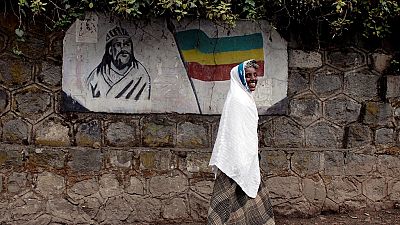Ethiopia
Ethiopians on Wednesday celebrated the decision by a London museum to hand back locks of hair cut from the corpse of an Ethiopian emperor during a British invasion 150 years ago.
Ethiopians, many dressed in the national colours of red, gold and green, cheered as staff at the National Army Museum handed over the remains in a black leather box to Ethiopia’s minister of culture, tourism and sport.
Hirut Kassaw will take the hair back to Ethiopia at the weekend where it will eventually be buried at the grave of Emperor Tewodros II at at monastery in northern Ethiopia, an embassy official said.
We want more
She thanked the museum for its “brave and principled” decision to hand over the hair, but called on it and other British institutions to return other items taken during the Victorian-era expedition.
“For Ethiopians, these are not simply artefacts or treasures but constitute a fundamental part of the existential fabric of Ethiopia and its people,” she said.
There was no immediate response to her request or statement on the return from the museum.
Successive emperors, governments and then activists have called for Britain to hand back crowns, religious regalia and illuminated manuscripts taken after the fight – in campaigns paralleled by Greece’s demands for its Parthenon sculptures, and Nigeria’s for the Benin Bronzes.
READ MORE: France to return 26 royal statues of Benin taken by army in 1892About Emperor Tewodros II
The emperor claimed a bloodline dating back to the biblical King Solomon and the Queen of Sheba.
Britain invaded his territory of then Abyssinia in 1867 to rescue a group of European missionaries, adventurers and officials – including the British consul – imprisoned by Tewodros after a series of diplomatic gaffes.
They reached his mountain fortress of Magdala in April 1868, defeated his troops and freed the prisoners. The emperor shot himself as the invaders stormed his last stronghold.
Journalists on the campaign described how soldiers descended on the emperor’s body and tore off strips of his clothing as souvenirs. The museum’s records suggest the hair was taken from Magdala by an artist on the British force.
Institutions including the British Museum have resisted repatriation campaigns citing legislation preventing them from breaking up collections and arguing that they can preserve items and present them to an international audience.
Campaigners have argued that a special case should be made for human remains.
REUTERS














00:58
Somaliland opposition leader wins presidential poll
11:07
Botswana's new government races to diversify its economy {Business Africa}
01:51
Meet the churches welcoming migrants across the world and championing diversity
Go to video
Ethiopian runner Yomif Kejelcha breaks men's half-marathon world record
00:41
Ethiopian PM Abiy Ahmed meets Putin at BRICS Summit, pushes for stronger trade ties
02:10
BRICS: African leaders call for reforms of international institutions